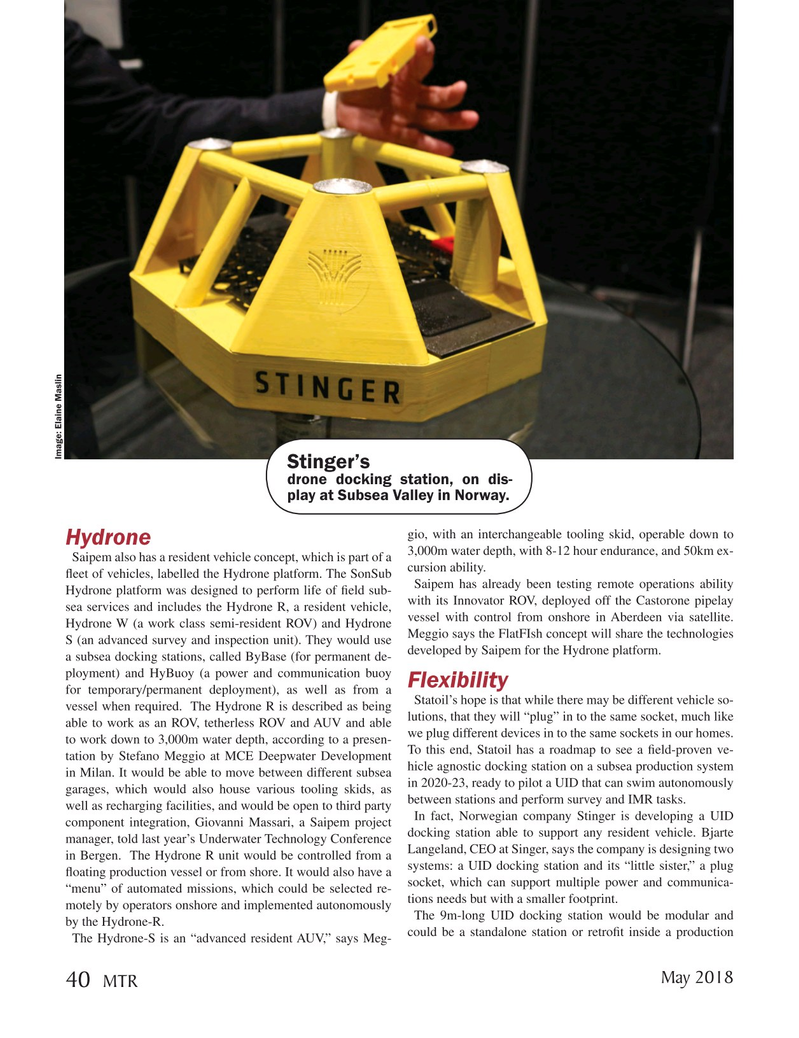
Page 40: of Marine Technology Magazine (May 2018)
Hydrographic Survey: Single beam and Multibeam Sonar
Read this page in Pdf, Flash or Html5 edition of May 2018 Marine Technology Magazine
Image: Elaine Maslin
Stinger’s drone docking station, on dis- play at Subsea Valley in Norway. gio, with an interchangeable tooling skid, operable down to
Hydrone 3,000m water depth, with 8-12 hour endurance, and 50km ex-
Saipem also has a resident vehicle concept, which is part of a cursion ability. ? eet of vehicles, labelled the Hydrone platform. The SonSub
Saipem has already been testing remote operations ability
Hydrone platform was designed to perform life of ? eld sub- sea services and includes the Hydrone R, a resident vehicle, with its Innovator ROV, deployed off the Castorone pipelay
Hydrone W (a work class semi-resident ROV) and Hydrone vessel with control from onshore in Aberdeen via satellite.
Meggio says the FlatFIsh concept will share the technologies
S (an advanced survey and inspection unit). They would use developed by Saipem for the Hydrone platform. a subsea docking stations, called ByBase (for permanent de- ployment) and HyBuoy (a power and communication buoy
Flexibility for temporary/permanent deployment), as well as from a
Statoil’s hope is that while there may be different vehicle so- vessel when required. The Hydrone R is described as being able to work as an ROV, tetherless ROV and AUV and able lutions, that they will “plug” in to the same socket, much like we plug different devices in to the same sockets in our homes. to work down to 3,000m water depth, according to a presen- tation by Stefano Meggio at MCE Deepwater Development To this end, Statoil has a roadmap to see a ? eld-proven ve- hicle agnostic docking station on a subsea production system in Milan. It would be able to move between different subsea garages, which would also house various tooling skids, as in 2020-23, ready to pilot a UID that can swim autonomously between stations and perform survey and IMR tasks. well as recharging facilities, and would be open to third party
In fact, Norwegian company Stinger is developing a UID component integration, Giovanni Massari, a Saipem project docking station able to support any resident vehicle. Bjarte manager, told last year’s Underwater Technology Conference in Bergen. The Hydrone R unit would be controlled from a Langeland, CEO at Singer, says the company is designing two systems: a UID docking station and its “little sister,” a plug ? oating production vessel or from shore. It would also have a socket, which can support multiple power and communica- “menu” of automated missions, which could be selected re- tions needs but with a smaller footprint. motely by operators onshore and implemented autonomously
The 9m-long UID docking station would be modular and by the Hydrone-R. could be a standalone station or retro? t inside a production
The Hydrone-S is an “advanced resident AUV,” says Meg-
May 2018 40
MTR
MTR #4 (34-49).indd 40 MTR #4 (34-49).indd 40 5/10/2018 9:43:59 AM5/10/2018 9:43:59 AM

 39
39

 41
41
